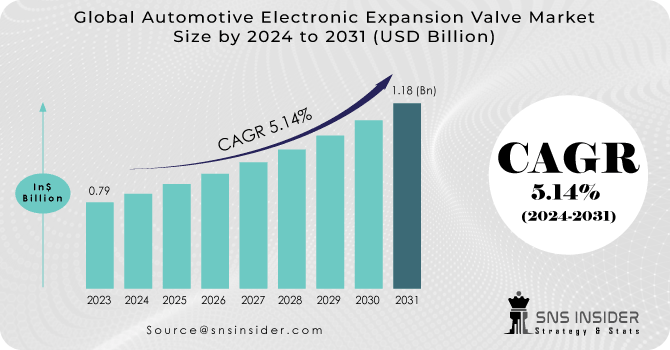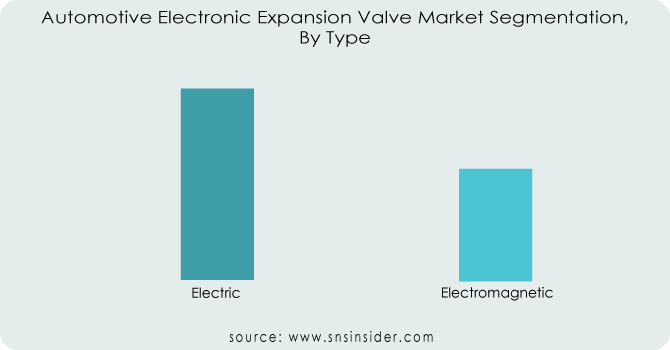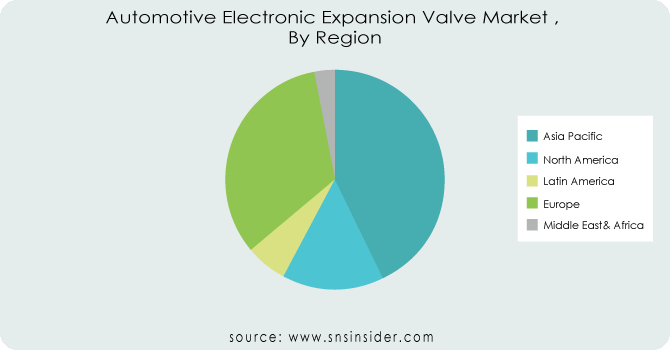
Get More Information on Automotive Electronic Expansion Valve Market - Request Sample Report
The Automotive Electronic Expansion Valve Market size was valued at USD 0.79 billion in 2023 and is expected to reach USD 1.18 billion by 2031 and grow at a CAGR of 5.14% over the forecast period 2024-2031.
In a car's air conditioning system, a key component for maintaining a comfortable and cool cabin is the Automotive Electronic Expansion Valve (EXV). This valve acts as a regulator, precisely controlling the amount of refrigerant that enters the evaporator. Unlike traditional valves, the EXV leverages electronic controls to adjust refrigerant flow based on real-time data like temperature and pressure within the system. This precise control ensures optimal cooling efficiency. By carefully managing the refrigerant, the EXV contributes to several benefits. It allows the air conditioning system to maintain the desired cabin temperature efficiently, reducing energy consumption and ultimately improving a vehicle's fuel economy. Additionally, the EXV's precise operation translates to a more comfortable driving experience for passengers by ensuring consistent and effective cooling. The applications for Automotive Electronic Expansion Valves are primarily within the automotive industry's air conditioning systems. They are prevalent in passenger cars, commercial vehicles, and any other automotive application where maintaining a controlled cabin climate is crucial. By precisely regulating refrigerant flow through the evaporator, EXVs play a vital role in achieving optimal cooling performance, improved fuel efficiency, and enhanced passenger comfort.
| Report Attributes | Details |
|---|---|
| Market Segmentation | • by Type (Electromagnetic, Electric) • by Application (Passenger Cars, Commercial Vehicles) |
| Regional Analysis | North America (US, Canada, Mexico), Europe (Eastern Europe [Poland, Romania, Hungary, Turkey, Rest of Eastern Europe] Western Europe] Germany, France, UK, Italy, Spain, Netherlands, Switzerland, Austria, Rest of Western Europe]), Asia Pacific (China, India, Japan, South Korea, Vietnam, Singapore, Australia, Rest of Asia Pacific), Middle East & Africa (Middle East [UAE, Egypt, Saudi Arabia, Qatar, Rest of Middle East], Africa [Nigeria, South Africa, Rest of Africa], Latin America (Brazil, Argentina, Colombia, Rest of Latin America) |
| Company Profiles | Fujikoki, CAREL INDUSTRIES, SANHUA, Saginomiya, Emerson, DunAn, Castel, VOLGA, Parker, Emerson, and Danfoss Group |
KEY DRIVERS:
Electronic Expansion Valves are getting smarter with better sensors, algorithms, and materials for precise car cooling control.
Car air conditioning and temperature control systems are getting a boost due to evolving Electronic Expansion Valves (EEVs). These valves, crucial for regulating refrigerant flow, are becoming more sophisticated due to advancements in technology. Better sensors provide real-time data on operating conditions, allowing the valve to precisely control refrigerant for optimal cooling. The smarter control algorithms, incorporating machine learning, enable EEVs to anticipate and adjust to changing needs. Furthermore, innovative materials are enhancing the durability and reliability of these valves. This progress paves the way for integrating EEVs into smart car systems, creating a more efficient and comfortable driving experience.
Electric Cars Drive Demand for Smarter Cooling Systems.
RESTRAINTS:
High initial cost of electronic expansion valves compared to traditional mechanical ones could hinder adoption.
Dependence on complex control systems and sensors might increase maintenance problems for some users.
OPPORTUNITIES:
The Automotive Electronic Expansion Valve market can thrive by catering to the growing demand for energy-efficient vehicles due to stricter emission regulations.
Rising consumer preference for in-cabin comfort can be addressed by EEVs that optimize air conditioning performance.
CHALLENGES:
Electrification challenges EEV manufacturers with unique thermal demands for battery systems and high-power electronics.
Unlike engines with consistent heat output, EVs require precise temperature control for both passenger comfort via air conditioning and optimal battery function. The high-powered electrical systems in EVs demand robust EEV technology that can handle these unique thermal characteristics and ensure durability. The rapid advancements in EV technology necessitate agility from EEV manufacturers to adapt their products to the ever-evolving needs of the electrified automotive landscape.
The Russia-Ukraine war has disrupted the supply chains of the Automotive Electronic Expansion Valve Market as both Russia and Ukraine are key suppliers of raw materials and components crucial for EEV production. This can lead to shortages and price hikes for EEVs. The war decreases the overall economic activity, potentially leading to decreased consumer demand for new vehicles, including those equipped with EEV technology. The sanctions imposed on Russia can restrict access to their EEV manufacturers, impacting market competition and potentially leading to production slowdowns. The war might indirectly benefit the market by accelerating the shift towards electric vehicles due to rising fuel prices. As electric vehicles require robust thermal management systems that utilize EEVs, this could create a long-term growth opportunity for the market.
An economic slowdown can disrupt the Automotive Electronic Expansion Valve (EEV) market by limiting consumer budgets during downturns lead to a potential 10-20% decline in new car sales, especially impacting EEVs which are often found in feature-rich newer vehicles. This decrease in demand is further amplified by automakers who react to lower consumer confidence by delaying production of 5-15% or reducing overall vehicle output. The cost-conscious consumers prioritize affordability over features during slowdowns, potentially leading to a 5-10% decline in EEV sales even within existing car models as they shift towards simpler vehicles. The combined effect of these factors could result in a contraction of the EEV market by 15-30% depending on the severity and duration of the economic slowdown. This causes to the potential production slowdowns, price wars among EEV manufacturers to stay competitive, and even job losses within the EEV industry.
By Type:
Electric
Electromagnetic
The Electric EEVs is the dominating sub-segment in the Automotive Electronic Expansion Valve Market by type holding around 60-70% of market share due to their superior control, accuracy and energy efficiency compared to electromagnetic EEVs. Electric expansion valves utilize the electric motor to regulate the flow of refrigerant, leading to optimal cabin comfort and fuel economy. This aligns well with growing demand for eco-friendly vehicles.

Get Customized Report as per your Business Requirement - Request For Customized Report
By Application:
Commercial Vehicles
Passenger Cars
The passenger car is the dominating sub-segment in the Automotive Electronic Expansion Valve Market by application holding around 55-65% of market share. This can be attributed to the rising demand for advanced features and in-cabin comfort in personal vehicles. EEVs contribute significantly to maintaining optimal cabin temperature and improving fuel efficiency, which are key priorities for passenger car buyers.
The Asia Pacific is the dominating region in the Automotive Electronic Expansion Valve Market holding around 40-45% of market share. This dominance stems from their growing car production which fuels demand for EEVs in new vehicles. The government initiatives promoting electric vehicles indirectly benefit the EEV market as electric cars rely heavily on this technology. Asia's strong EEV component supply chain also contributes to potentially lower production costs, making EEVs more accessible. Europe is the second highest region with 30-35% of market share driven by their stringent emission regulations that push carmakers towards fuel-efficient technologies like EEVs. European consumers' preference for advanced features like automatic climate control, which necessitates EEVs, further strengthens their market position.

REGIONAL COVERAGE:
North America
US
Canada
Mexico
Europe
Eastern Europe
Poland
Romania
Hungary
Turkey
Rest of Eastern Europe
Western Europe
Germany
France
UK
Italy
Spain
Netherlands
Switzerland
Austria
Rest of Western Europe
Asia Pacific
China
India
Japan
South Korea
Vietnam
Singapore
Australia
Rest of Asia Pacific
Middle East & Africa
Middle East
UAE
Egypt
Saudi Arabia
Qatar
Rest of the Middle East
Africa
Nigeria
South Africa
Rest of Africa
Latin America
The major key players are Fujikoki, CAREL INDUSTRIES, SANHUA, Saginomiya, Emerson, DunAn, Castel, VOLGA, Parker, Emerson, Danfoss Group and other key players.
Saginomiya-Company Financial Analysis

In Oct 2020: Saginomiya's innovation was recognized at CEATEC 2020. Their participation in a NEDO project resulted in a Grand Prix win for the most cutting-edge technology exhibited. This project involved a vibrational energy harvester.
| Report Attributes | Details |
|---|---|
| Market Size in 2023 | US$ 0.79 Billion |
| Market Size by 2031 | US$ 1.18 Billion |
| CAGR | CAGR of 5.14% From 2024 to 2031 |
| Base Year | 2023 |
| Forecast Period | 2024-2031 |
| Historical Data | 2020-2022 |
| Report Scope & Coverage | Market Size, Segments Analysis, Competitive Landscape, Regional Analysis, DROC & SWOT Analysis, Forecast Outlook |
| Key Segments | • by Type (Electromagnetic, Electric) • by Application (Passenger Cars, Commercial Vehicles) |
| Regional Analysis/Coverage |
North America (US, Canada, Mexico), Europe (Eastern Europe [Poland, Romania, Hungary, Turkey, Rest of Eastern Europe] Western Europe] Germany, France, UK, Italy, Spain, Netherlands, Switzerland, Austria, Rest of Western Europe]), Asia Pacific (China, India, Japan, South Korea, Vietnam, Singapore, Australia, Rest of Asia Pacific), Middle East & Africa (Middle East [UAE, Egypt, Saudi Arabia, Qatar, Rest of Middle East], Africa [Nigeria, South Africa, Rest of Africa], Latin America (Brazil, Argentina, Colombia Rest of Latin America |
| Company Profiles | Fujikoki, CAREL INDUSTRIES, SANHUA, Saginomiya, Emerson, DunAn, Castel, VOLGA, Parker, Emerson, and Danfoss Group |
| Key Drivers | •The adoption of the vehicle electronic expansion valve is motivated by the need to improve the engine's fuel economy. •The rising preference for freight transportation on roadways is expected to drive sales of HCVs. |
| RESTRAINTS | •The vehicle electronic expansion valve market may be constrained by high initial and maintenance expenses. •The rising usage of electric vehicles around the world is projected to restrain the worldwide market's growth. |
The Automotive Electronic Expansion Valve Market was valued at USD 0.79 billion in 2023.
The expected CAGR of the global Automotive Electronic Expansion Valve Market during the forecast period is 5.14%.
Electronic expansion valves in automobiles not only improve performance but also cut energy consumption. Precision control and a larger component load fluctuation than thermal expansion valves are some of the advantages of these valves.
Table of Contents
1. Introduction
1.1 Market Definition
1.2 Scope
1.3 Research Assumptions
2. Research Methodology
3. Market Dynamics
3.1 Drivers
3.2 Restraints
3.3 Opportunities
3.4 Challenges
4. Impact Analysis
4.1 COVID-19 Impact Analysis
4.2 Impact of Ukraine- Russia war
4.3 Impact of ongoing Recession
4.3.1 Introduction
4.3.2 Impact on major economies
4.3.2.1 US
4.3.2.2 Canada
4.3.2.3 Germany
4.3.2.4 France
4.3.2.5 United Kingdom
4.3.2.6 China
4.3.2.7 Japan
4.3.2.8 South Korea
4.3.2.9 Rest of the World
5. Value Chain Analysis
6. Porter’s 5 forces model
7. PEST Analysis
8. Global Automotive Electronic Expansion Valve Market Segmentation, by Type
8.1 Electric
8.2 Electromagnetic
9. Global Automotive Electronic Expansion Valve Market Segmentation, by Application
9.1 Commercial Vehicles
9.2 Passenger Cars
10. Regional Analysis
10.1 Introduction
10.2 North America
10.2.1 the USA
10.2.2 Canada
10.2.3 Mexico
10.3 Europe
10.3.1 Germany
10.3.2 the UK
10.3.3 France
10.3.4 Italy
10.3.5 Spain
10.3.6 The Netherlands
10.3.7 Rest of Europe
10.4 Asia-Pacific
10.4.1 Japan
10.4.2 South Korea
10.4.3 China
10.4.4 India
10.4.5 Australia
10.4.6 Rest of Asia-Pacific
10.5 The Middle East & Africa
10.5.1 Israel
10.5.2 UAE
10.5.3 South Africa
10.5.4 Rest
10.6 Latin America
10.6.1 Brazil
10.6.2 Argentina
10.6.3 Rest of Latin America
11. Company Profiles
11.1 Castel
11.1.1 Financial
11.1.2 Products/ Services Offered
11.1.3 SWOT Analysis
11.1.4 The SNS view
11.2 Fujikoki
11.3 CAREL INDUSTRIES
11.4 SANHUA
11.5 Saginomiya
11.6 Emerson
11.7 DunAn
11.8 Castel
11.9 VOLGA
11.10 Parker
11.11 Emerson
11.12 Danfoss Group
12. Competitive Landscape
12.1 Competitive Benchmarking
12.2 Market Share analysis
12.3 Recent Developments
13. Conclusion
An accurate research report requires proper strategizing as well as implementation. There are multiple factors involved in the completion of good and accurate research report and selecting the best methodology to compete the research is the toughest part. Since the research reports we provide play a crucial role in any company’s decision-making process, therefore we at SNS Insider always believe that we should choose the best method which gives us results closer to reality. This allows us to reach at a stage wherein we can provide our clients best and accurate investment to output ratio.
Each report that we prepare takes a timeframe of 350-400 business hours for production. Starting from the selection of titles through a couple of in-depth brain storming session to the final QC process before uploading our titles on our website we dedicate around 350 working hours. The titles are selected based on their current market cap and the foreseen CAGR and growth.
The 5 steps process:
Step 1: Secondary Research:
Secondary Research or Desk Research is as the name suggests is a research process wherein, we collect data through the readily available information. In this process we use various paid and unpaid databases which our team has access to and gather data through the same. This includes examining of listed companies’ annual reports, Journals, SEC filling etc. Apart from this our team has access to various associations across the globe across different industries. Lastly, we have exchange relationships with various university as well as individual libraries.

Step 2: Primary Research
When we talk about primary research, it is a type of study in which the researchers collect relevant data samples directly, rather than relying on previously collected data. This type of research is focused on gaining content specific facts that can be sued to solve specific problems. Since the collected data is fresh and first hand therefore it makes the study more accurate and genuine.
We at SNS Insider have divided Primary Research into 2 parts.
Part 1 wherein we interview the KOLs of major players as well as the upcoming ones across various geographic regions. This allows us to have their view over the market scenario and acts as an important tool to come closer to the accurate market numbers. As many as 45 paid and unpaid primary interviews are taken from both the demand and supply side of the industry to make sure we land at an accurate judgement and analysis of the market.
This step involves the triangulation of data wherein our team analyses the interview transcripts, online survey responses and observation of on filed participants. The below mentioned chart should give a better understanding of the part 1 of the primary interview.

Part 2: In this part of primary research the data collected via secondary research and the part 1 of the primary research is validated with the interviews from individual consultants and subject matter experts.
Consultants are those set of people who have at least 12 years of experience and expertise within the industry whereas Subject Matter Experts are those with at least 15 years of experience behind their back within the same space. The data with the help of two main processes i.e., FGDs (Focused Group Discussions) and IDs (Individual Discussions). This gives us a 3rd party nonbiased primary view of the market scenario making it a more dependable one while collation of the data pointers.
Step 3: Data Bank Validation
Once all the information is collected via primary and secondary sources, we run that information for data validation. At our intelligence centre our research heads track a lot of information related to the market which includes the quarterly reports, the daily stock prices, and other relevant information. Our data bank server gets updated every fortnight and that is how the information which we collected using our primary and secondary information is revalidated in real time.

Step 4: QA/QC Process
After all the data collection and validation our team does a final level of quality check and quality assurance to get rid of any unwanted or undesired mistakes. This might include but not limited to getting rid of the any typos, duplication of numbers or missing of any important information. The people involved in this process include technical content writers, research heads and graphics people. Once this process is completed the title gets uploader on our platform for our clients to read it.
Step 5: Final QC/QA Process:
This is the last process and comes when the client has ordered the study. In this process a final QA/QC is done before the study is emailed to the client. Since we believe in giving our clients a good experience of our research studies, therefore, to make sure that we do not lack at our end in any way humanly possible we do a final round of quality check and then dispatch the study to the client.
The Automotive Metal Stamping Market Size was valued at USD 108.41 Bn in 2023 and will reach USD 163.90 Bn by 2032 and grow at a CAGR of 4.7% by 2024-2032
The Automotive 3D Map System Market System was recorded at USD 4.7 Bn in 2023 and is expected to reach USD 14 Bn by 2031 and grow at a CAGR of 12.9% over the forecast period of 2024-2031.
The Automotive Interior Materials Market was valued at USD 60.9 Billion in 2023 and is expected to reach USD 86.2 Billion by 2032, growing at a CAGR of 3.96% from 2024-2032.
The Truck Rental Market Size was valued at $125.50 billion in 2023 and is expected to reach $218.87 billion by 2031 and grow at a CAGR of 7.2% by 2024-2031
The Automotive Active Spoiler Market size was valued at USD 3.98 billion in 2023 and is expected to reach USD 6.82 billion by 2031 and grow at a CAGR of 6.96% over the forecast period 2024-2031.
The Automotive Center Stack Market is expected to grow at a CAGR of 6.8% over the forecast period of 2023-2030.
Hi! Click one of our member below to chat on Phone